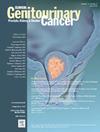局部晚期或转移性尿路上皮癌患者的现实世界治疗模式和临床结果通过维持阿维单抗的资格
IF 2.3
3区 医学
Q3 ONCOLOGY
引用次数: 0
摘要
导读:1L PBC历来被推荐用于la/mUC患者。维持性avelumab推荐用于1L PBC后无疾病进展的患者。真实世界中符合维持性avelumab治疗的患者比例数据有限,不符合维持性avelumab治疗的患者的预后也不确定。该研究评估了la/mUC初始1L PBC患者中符合维持阿维单抗条件的比例,以及符合维持阿维单抗条件的1L PBC患者的真实结局。方法:使用纵向电子健康记录衍生数据库进行回顾性观察性研究,该数据库包括未识别的患者水平结构化和非结构化数据,包括接受1L PBC≥1剂量的Ia/mUC成人(2020年4月至2022年1月)。评估符合维持阿维单抗治疗条件的患者比例(真实世界疾病稳定、部分缓解或1L PBC后完全缓解),并评估符合和不符合维持阿维单抗治疗条件的患者的中位总生存期(mOS)。结果:在336例接受1L PBC治疗的Ia/mUC患者中(55.4%接受顺铂为主的治疗,44.6%接受卡铂为主的治疗);181例(54%)符合维持avelumab的条件;138例(41%)维持avelumab不合格(17例(5%)不可评估)。在181例符合维持阿维单抗条件的患者中,67例(37.0%;在所有1L例接受pbc治疗的患者中,有19.9%接受了维持性avelumab治疗。所有1L接受pbc治疗的患者的mOS (95% CI)为15.0(12.2-19.6)个月,不符合维持阿维单抗条件的患者的mOS (95% CI)为8.0(6.7-10.3)个月;而在符合维持阿维单抗条件的患者中(包括37%接受维持阿维单抗治疗的患者),生存期为27.6个月(23.4个月未达到)。结论:在这项研究中,大约一半的1L pbc治疗患者符合维持avelumab的条件,五分之一的患者接受了维持avelumab。实际OS对于总体1L pbc治疗人群来说仍然很短。这些结果支持使用治疗指南首选的1L治疗方案,证明所有la/mUC患者的生存获益,并且适用于患者,无论其是否有资格接受顺铂或对PBC有反应。本文章由计算机程序翻译,如有差异,请以英文原文为准。
Real-World Treatment Patterns and Clinical Outcomes in Patients With Locally Advanced or Metastatic Urothelial Carcinoma by Eligibility for Maintenance Avelumab
Introduction
1L PBC has historically been recommended for patients with la/mUC. Maintenance avelumab is recommended for patients without disease progression following 1L PBC. Real-world data on the proportion of patients eligible for maintenance avelumab are limited, and outcomes among patients ineligible for maintenance avelumab are uncertain. This study assessed the proportion of patients with la/mUC initiating 1L PBC who were maintenance-avelumab eligible and real-world outcomes following 1L PBC by maintenance-avelumab eligibility.
Methods
A retrospective, observational study was conducted using a longitudinal electronic health record–derived database comprising de-identified patient-level structured and unstructured data including adults with Ia/mUC who received ≥1 dose of 1L PBC (April 2020-January 2022). The proportion of patients eligible for maintenance avelumab (real-world stable disease, partial response, or complete response following 1L PBC) was estimated and median overall survival (mOS) assessed for maintenance avelumab–eligible and –ineligible patients.
Results
Of 336 patients with Ia/mUC treated with 1L PBC (55.4% received cisplatin-based treatment 44.6% carboplatin-based treatment); 181 (54%) were maintenance-avelumab eligible; and 138 (41%) maintenance-avelumab ineligible (17 [5%] were nonevaluable). Of 181 maintenance-avelumab–eligible patients, 67 (37.0%; 19.9% of all 1L PBC–treated patients) received maintenance avelumab. mOS (95% CI) among all 1L PBC–treated patients was 15.0 (12.2-19.6) months and among maintenance-avelumab–ineligible patients was 8.0 (6.7-10.3) months; whereas among maintenance-avelumab–eligible patients (including 37% who received maintenance avelumab), mOS was 27.6 (23.4-not reached) months.
Conclusions
In this study, approximately half of 1L PBC–treated patients were maintenance-avelumab eligible, and one-fifth received it. Real-world OS remains short for the overall 1L PBC–treated population. These results support the use of treatment-guideline preferred 1L treatment options that demonstrate survival benefit for all patients with la/mUC, and are available to patients irrespective of their eligibility for cisplatin, or response to PBC.
求助全文
通过发布文献求助,成功后即可免费获取论文全文。
去求助
来源期刊

Clinical genitourinary cancer
医学-泌尿学与肾脏学
CiteScore
5.20
自引率
6.20%
发文量
201
审稿时长
54 days
期刊介绍:
Clinical Genitourinary Cancer is a peer-reviewed journal that publishes original articles describing various aspects of clinical and translational research in genitourinary cancers. Clinical Genitourinary Cancer is devoted to articles on detection, diagnosis, prevention, and treatment of genitourinary cancers. The main emphasis is on recent scientific developments in all areas related to genitourinary malignancies. Specific areas of interest include clinical research and mechanistic approaches; drug sensitivity and resistance; gene and antisense therapy; pathology, markers, and prognostic indicators; chemoprevention strategies; multimodality therapy; and integration of various approaches.
 求助内容:
求助内容: 应助结果提醒方式:
应助结果提醒方式:


